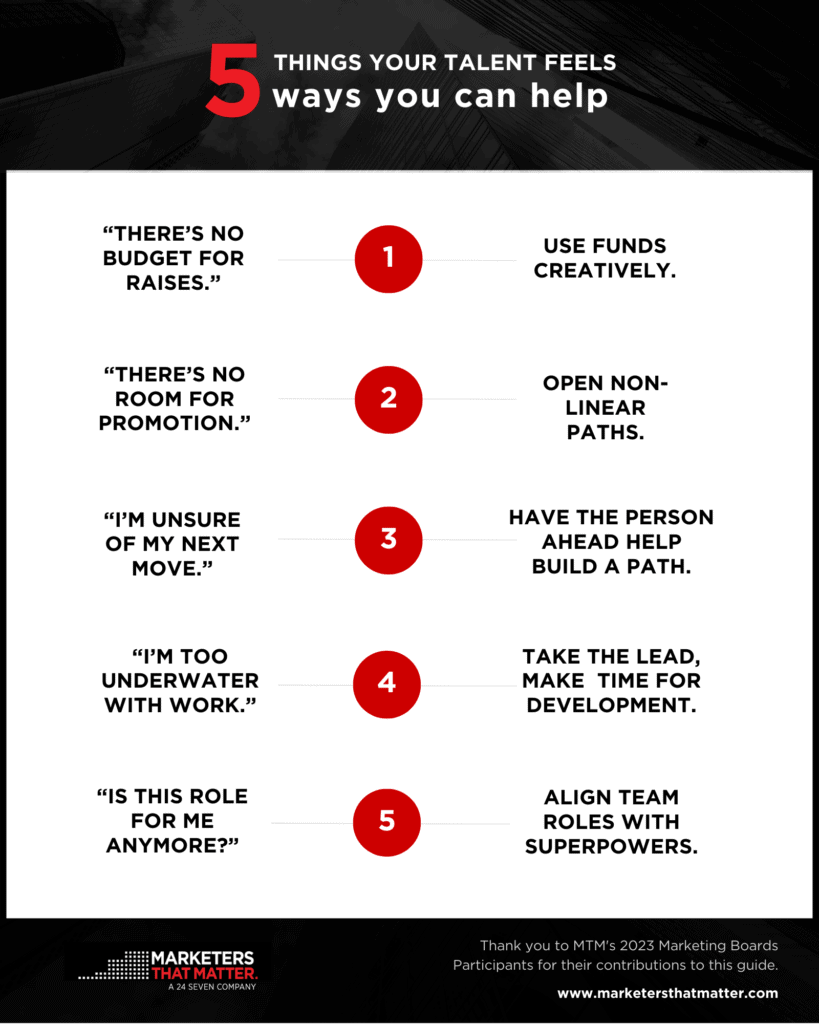With a major talent shortage and increasing skill gaps, investing in your top talent’s growth and development has never been more important. But budgets are shrinking, and there are often organizational limitations that make it challenging to make the case and space for investing in the team. Below are practical ways to invest in your teams’ development and growth, curated by senior-level marketers on MTM’s Marketing Boards, despite five prevalent roadblocks: budget constraints, title compression, lack of career pathing, burdening workload, and misalignment of skills.
.
Here are five things your talent feels and five quick ways to combat your top talent’s roadblocks to growth–but keep scrolling for actionable ideas.

1. Budget Constraints
What your top talent feels:
“There is no budget for raises right now.”
What leaders can do:
Show investment in them in other meaningful ways.
- Start with transparent and honest conversations about expectations and what’s possible/realistic to support. Having open and honest dialogue with each team member about what’s possible right now/what’s not goes a long way.
- Just because company-wide raises aren’t happening, that doesn’t mean funds for professional development (i.e. executive coaching, specialized training and certifications) are out of the question. Find out how you can use approved budgets creatively (or reallocate from untapped areas) to support your team’s growth.
- Ensure folks on your team know what is currently available to them. Oftentimes, funds for development are pre-approved as part of marketing’s budget but go unused simply because folks don’t know they are available.
- Never take for granted that when you ask for more and are getting more, you need to give back in some way. If a raise isn’t an option, create a fund for rewarding above and beyond contributions – (i.e., gift certificates for appreciation, take them to lunch, spend an hour more helping them think through how the more now will help them more later in their career paths, etc.)
Advice from a Marketing Board Member: “Some employees value the opportunity to travel, attend events and/or get exposure to senior executives within the organization. Finding areas to reward strong performance beyond monetary compensation can sometimes be more simple than we think. The key is to understand what motivates and excites the person.”
Nicole Lee, Senior Director, Integrated Marketing, NHL
2. Title Compression
What your top talent feels:
“There’s no room for me to get promoted.”
What Leaders can do:
Change the perception of what growth means.
- Create non-linear paths for folks, i.e., leadership vs. technical/practitioner paths, stretch assignments, and bake that into quarterly and annual reviews (people treasure what you measure).
- Implement rotational programs: Encourage horizontal growth and development when the upward trajectory is a challenge.
- Identify and communicate opportunities for lateral movement, expanded responsibilities, or cross-functional collaborations.
- Create a formalized program around stretch opportunities, giving it attention and space to be prioritized and recognized. Use real business challenges and projects to make it purposeful and not extra work.
- Implement a recognition and rewards program that highlights exceptional contributions, fostering a sense of accomplishment and growth.
3. Lack of Career Pathing
What your top talent feels:
“I don’t know what my next move should be.”
What Leaders can do:
Help them build a path.
- When meeting 1:1, build in time to ask questions about their career aspirations to truly understand their goals beyond their day-to-day role. The path you help them build may extend beyond what your company can offer.
- Encourage outside mentorship: Guide your direct reports to seek mentorship from leaders outside the organization and motivate them to become mentors themselves as a way to grow their skills.
- Invite leaders showcasing different career paths to speak to your team to demonstrate that advancement isn’t always linear.
- For high-potential people on your team, find them internal cross-functional mentors to provide expanded input from all parts of the organization and internal sponsors who will encourage their inclusion across the organization
Heard on Visionaries Podcast: “Every individual needs a personalized career path. If they know what they want to do, help them find a way to get there. But if they don’t, take them on a journey to find out. Ask questions, show them different roles, and introduce them to new mentors. Help them find a path that is theirs and then work back from there on a development plan.”
Vineet Mehra, CMO of Chime
4. Burdening Workload
What your top talent feels:
“I’m so underwater with work, I have no time to focus on my own development.”
What Leaders can do:
Make time and space for development.
- Acknowledge that people are feeling overwhelmed.
- Lead by example. Block your own calendar for 1-2 hrs every week and let the team know that you are taking that time for self-reflection, strategy, and prioritization of your own workload. Encourage them to do the same and respect that time.
- Establish common quiet times for the team, where they are given permission to get their work done and not be in meetings (Ex., Zoom-free Fridays.)
- Utilize team meetings and 1:1s to give your team time for tasks like self-evaluations and reflection on accomplishments. This demonstrates that their growth matters and brings priority to their development.
- Make a consistent commitment to these practices.
Advice from an MTM Visionary: “We’ve created oxygen moments where employees have time to think about their impact and their career path. We want them to stay with us, so we need to give them time to form a clear view of the path ahead.”
Lorraine Barber-Miller, EVP and Chief Marketing & E-Commerce Officer, Philips
5. Misalignment of Skills
What your top talent feels:
“Is this role even the right fit for me anymore?”
What Leaders can do:
Right-sizing based on skill sets.
- Provide opportunities for self-assessment and reflection, enabling team members to gauge their alignment with their current roles and contribute to their own growth.
- Address evolving role concerns proactively through open conversations, identifying potential changes or adjustments that benefit both the individual and the organization.
Advice from a Marketing Board Member: “It’s becoming super complex to understand the various skill sets we need for marketing now and into the future, i.e. will we need more specialists or generalists? We’re working closely with our Marketing Excellence team to identify skill gaps and through a culture of coaching, develop our teams to reduce those gaps.”
Nicole Romoli, SVP, Growth Marketing & Operations, Coupa
By following these strategies, senior marketing leaders can create an environment where talent development and growth are prioritized, even within the constraints of budgets and organizational limitations. This approach not only enhances team members’ skills and performance but can also help support overall job satisfaction and loyalty.
Thank you to the following MTM Marketing Board participants who contributed to this guide on Investing in Talent:
Nicole Romoli, SVP, Growth Marketing & Operations, Coupa
Nicolas Hanssens, Global Head of Digital Transformation, Logitech
Nicole Lee, Senior Director, Integrated Marketing, NHL
Doug Frisbie, former VP, Global Business Marketing, Snap Inc.
Rob Whitney, Vice President Global Marketing, Univar Solutions
Christine Beury, VP of Enterprise Marketing Campaigns, Zendesk
Want in on the fun?


